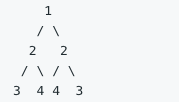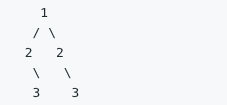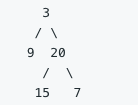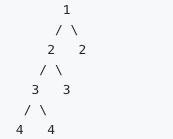LeetCode(101-110)
101. Symmetric Tree¶
- Tree
- Depth-first Search
- Breadth-first Search
Given a binary tree, check whether it is a mirror of itself (ie, symmetric around its center).
For example, this binary tree
[1,2,2,3,4,4,3]is symmetric:
But the following
[1,2,2,null,3,null,3]is not:
Note: Bonus points if you could solve it both recursively and iteratively.
Solution
Runtime 0 ms
/**
* Definition for a binary tree node.
* public class TreeNode {
* int val;
* TreeNode left;
* TreeNode right;
* TreeNode(int x) { val = x; }
* }
*/
class Solution {
public boolean isSymmetric(TreeNode root) {
if (root == null) return true;
return isSymmetric(root.left, root.right);
}
public boolean isSymmetric(TreeNode p, TreeNode q) {
if (p == null && q == null) return true;
if (p == null || q == null) return false;
if (p.val != q.val) return false;
return isSymmetric(p.left, q.right) && isSymmetric(p.right, q.left);
}
}
102. Binary Tree Level Order Traversal¶
- Tree
- Breadth-first Search
Given a binary tree, return the level order traversal of its nodes' values. (ie, from left to right, level by level).
For example: Given binary tree
[3,9,20,null,null,15,7],
return its level order traversal as:
[
[3],
[9,20],
[15,7]
]
Solution
Runtime 1 ms
/**
* Definition for a binary tree node.
* public class TreeNode {
* int val;
* TreeNode left;
* TreeNode right;
* TreeNode(int x) { val = x; }
* }
*/
class Solution {
public List<List<Integer>> levelOrder(TreeNode root) {
List<List<Integer>> result = new ArrayList<>();
if (root == null) return result;
List<Integer> level = new ArrayList<>();
Queue<TreeNode> queue = new LinkedList<>();
queue.offer(root);
int nextLevel = 0, current = 1;
while (!queue.isEmpty()) {
TreeNode node = queue.poll();
if (node.left != null) {
queue.offer(node.left);
nextLevel++;
}
if (node.right != null) {
queue.offer(node.right);
nextLevel++;
}
level.add(node.val);
if (--current == 0) {
current = nextLevel;
nextLevel = 0;
result.add(new ArrayList<>(level));
level.clear();
}
}
return result;
}
}
103. Binary Tree Zigzag Level Order Traversal¶
- Stack
- Tree
- Breadth-first Search
Given a binary tree, return the zigzag level order traversal of its nodes' values. (ie, from left to right, then right to left for the next level and alternate between).
For example: Given binary tree
[3,9,20,null,null,15,7],
return its level order traversal as:
[
[3],
[20,9],
[15,7]
]
Solution
按之字形顺序打印二叉树需要两个栈。我们在打印某一层节点时,把下一层的子节点保存在对应的栈中。如果当前打印的是奇数层,则先保存左子节点再保存右子节点到第一个栈里;如果当前打印的是偶数层,则先保存右子节点再保存左子节点到第二个栈里。
Runtime 1 ms
/**
* Definition for a binary tree node.
* public class TreeNode {
* int val;
* TreeNode left;
* TreeNode right;
* TreeNode(int x) { val = x; }
* }
*/
class Solution {
public List<List<Integer>> zigzagLevelOrder(TreeNode root) {
List<List<Integer>> result = new ArrayList<>();
if (root == null) return result;
List<Integer> level = new ArrayList<>();
Stack<TreeNode>[] stack = new Stack[2];
stack[0] = new Stack<>();
stack[1] = new Stack<>();
int index = 0;
stack[index].push(root);
while (!stack[index].isEmpty()) {
TreeNode node = stack[index].pop();
if (index == 0) {
if (node.left != null) {
stack[1 - index].push(node.left);
}
if (node.right != null) {
stack[1 - index].push(node.right);
}
} else {
if (node.right != null) {
stack[1 - index].push(node.right);
}
if (node.left != null) {
stack[1 - index].push(node.left);
}
}
level.add(node.val);
if (stack[index].isEmpty()) {
index = 1 - index;
result.add(new ArrayList<>(level));
level.clear();
}
}
return result;
}
}
104. Maximum Depth of Binary Tree¶
- Tree
- Depth-first Search
Given a binary tree, find its maximum depth.
The maximum depth is the number of nodes along the longest path from the root node down to the farthest leaf node.
Note: A leaf is a node with no children.
Example:
Given binary tree
[3,9,20,null,null,15,7],
return its depth = 3.
Solution
Runtime 0 ms
/**
* Definition for a binary tree node.
* public class TreeNode {
* int val;
* TreeNode left;
* TreeNode right;
* TreeNode(int x) { val = x; }
* }
*/
class Solution {
public int maxDepth(TreeNode root) {
if (root == null) return 0;
if (root.left == null && root.right == null) return 1;
return Math.max(maxDepth(root.left), maxDepth(root.right)) + 1;
}
}
105. Construct Binary Tree from Preorder and Inorder Traversal¶
- Tree
- Depth-first Search
Given preorder and inorder traversal of a tree, construct the binary tree.
Note:
You may assume that duplicates do not exist in the tree.For example, given
preorder = [3,9,20,15,7]
inorder = [9,3,15,20,7]Return the following binary tree:
此题同CI-7-重建二叉树
Solution
算法思路是先根据前序序列找到根节点,然后在中序序列中找到该节点,其左边的就是树的左子树,右边就是右子树。由于每次都需要在中序中查找节点,所以这里采用了一个Map保存中序的值-索引,这样是一种空间换时间的解法。
Runtime 2 ms, faster than 96.74%. Memory Usage 39.8 MB, less than 14.34%.
/**
* Definition for a binary tree node.
* public class TreeNode {
* int val;
* TreeNode left;
* TreeNode right;
* TreeNode(int x) { val = x; }
* }
*/
class Solution {
public TreeNode buildTree(int[] preorder, int[] inorder) {
Map<Integer, Integer> inMap = new HashMap<>(inorder.length);
for (int i = 0; i < inorder.length; i++) {
inMap.put(inorder[i], i);
}
return buildTreeRecursion(
preorder, 0, preorder.length - 1,
inMap, 0, inorder.length - 1
);
}
private TreeNode buildTreeRecursion(int[] preorder, int preStart, int preEnd, Map<Integer, Integer> inMap, int inStart, int inEnd) {
if (preStart > preEnd || inStart > inEnd) return null;
TreeNode root = new TreeNode(preorder[preStart]);
if (preStart == preEnd && inStart == inEnd) return root;
int i = inMap.get(root.val);
root.left = buildTreeRecursion(
preorder, preStart + 1, preStart + i - inStart,
inMap, inStart, i - 1
);
root.right = buildTreeRecursion(
preorder, preStart + i - inStart + 1, preEnd,
inMap, i + 1, inEnd
);
return root;
}
}
106. Construct Binary Tree from Inorder and Postorder Traversal¶
- Tree
- Depth-first Search
Given inorder and postorder traversal of a tree, construct the binary tree.
Note:
You may assume that duplicates do not exist in the tree.For example, given
inorder = [9,3,15,20,7]
postorder = [9,15,7,20,3]Return the following binary tree:
Solution
算法思路是先根据后序序列中从后往前找到根节点,然后在中序序列中找到该节点,其左边的就是树的左子树,右边就是右子树。由于每次都需要在中序中查找节点,所以这里采用了一个Map保存中序的值-索引,这样是一种空间换时间的解法。
Runtime 2 ms, faster than 92.72%. Memory Usage 40.1 MB, less than 15.75%.
/**
* Definition for a binary tree node.
* public class TreeNode {
* int val;
* TreeNode left;
* TreeNode right;
* TreeNode(int x) { val = x; }
* }
*/
class Solution {
public TreeNode buildTree(int[] inorder, int[] postorder) {
Map<Integer, Integer> inMap = new HashMap<>(inorder.length);
for (int i = 0; i < inorder.length; i++) {
inMap.put(inorder[i], i);
}
return buildTree(
inMap, 0, inorder.length - 1,
postorder, 0, postorder.length - 1);
}
private TreeNode buildTree(Map<Integer, Integer> inMap, int inStart, int inEnd, int[] postorder, int postStart, int postEnd) {
if (inStart > inEnd || postStart > postEnd) return null;
TreeNode root = new TreeNode(postorder[postEnd]);
if (inStart == inEnd && postStart == postEnd) return root;
int i = inMap.get(root.val);
root.left = buildTree(
inMap, inStart, i - 1,
postorder, postStart, postStart + i - inStart - 1);
root.right = buildTree(
inMap, i + 1, inEnd,
postorder, postStart + i - inStart, postEnd - 1);
return root;
}
}
107. Binary Tree Level Order Traversal II¶
- Tree
- Breadth-first Search
Given a binary tree, return the bottom-up level order traversal of its nodes' values. (ie, from left to right, level by level from leaf to root).
For example: Given binary tree
[3,9,20,null,null,15,7],
return its level order traversal as:
[
[15,7],
[9,20],
[3]
]
Solution
在LC-102-Binary Tree Level Order Traversal的基础上,将每层的结果插入到链头即可。所以,结果采用LinkedList保存。
Runtime 1 ms
/**
* Definition for a binary tree node.
* public class TreeNode {
* int val;
* TreeNode left;
* TreeNode right;
* TreeNode(int x) { val = x; }
* }
*/
class Solution {
public List<List<Integer>> levelOrderBottom(TreeNode root) {
List<Integer> level = new ArrayList<>();
List<List<Integer>> result = new LinkedList<>();
Queue<TreeNode> queue = new LinkedList<>();
if (root == null) return result;
int current = 1, nextLevel = 0;
queue.offer(root);
while (!queue.isEmpty()) {
TreeNode node = queue.poll();
if (node.left != null) {
queue.offer(node.left);
nextLevel++;
}
if (node.right != null) {
queue.offer(node.right);
nextLevel++;
}
level.add(node.val);
if (--current == 0) {
current = nextLevel;
nextLevel = 0;
result.add(0, new ArrayList<>(level));
level.clear();
}
}
return result;
}
}
108. Convert Sorted Array to Binary Search Tree¶
- Tree
- Depth-first Search
Given an array where elements are sorted in ascending order, convert it to a height balanced BST.
For this problem, a height-balanced binary tree is defined as a binary tree in which the depth of the two subtrees of every node never differ by more than 1.
Example:
Given the sorted array: [-10,-3,0,5,9],
One possible answer is: [0,-3,9,-10,null,5], which represents the following height balanced BST:
Solution
该题比较简单,需要注意的是,要按照实例给的规律来生成平衡的二叉搜索树。
Runtime 1 ms
/**
* Definition for a binary tree node.
* public class TreeNode {
* int val;
* TreeNode left;
* TreeNode right;
* TreeNode(int x) { val = x; }
* }
*/
class Solution {
public TreeNode sortedArrayToBST(int[] nums) {
if (nums == null || nums.length == 0) return null;
return buildTree(nums, 0, nums.length - 1);
}
private TreeNode buildTree(int[] nums, int start, int end) {
if (start > end) return null;
int mid = start + ((end - start + 1) >>> 1);
TreeNode root = new TreeNode(nums[mid]);
root.left = buildTree(nums, start, mid - 1);
root.right = buildTree(nums, mid + 1, end);
return root;
}
}
109. Convert Sorted List to Binary Search Tree¶
- Linked List
- Depth-first Search
Given a singly linked list where elements are sorted in ascending order, convert it to a height balanced BST.
For this problem, a height-balanced binary tree is defined as a binary tree in which the depth of the two subtrees of every node never differ by more than 1.
Example:
Given the sorted array: [-10,-3,0,5,9],
One possible answer is: [0,-3,9,-10,null,5], which represents the following height balanced BST:
Solution
可以先将链表转换为一个数组,然后用上一题的解法——将不熟悉的东西转化为熟悉的东西。
然而,这么做肯定不是此题的本意。此题的要点就是在一个区间内找到中间的节点,然后递归,所以可以使用双指针的思路。一个慢指针,每次走一步;一个快指针,每次都两步。当快指针走完后,慢指针就在中间位置了。
Runtime 1 ms
/**
* Definition for singly-linked list.
* public class ListNode {
* int val;
* ListNode next;
* ListNode(int x) { val = x; }
* }
*/
/**
* Definition for a binary tree node.
* public class TreeNode {
* int val;
* TreeNode left;
* TreeNode right;
* TreeNode(int x) { val = x; }
* }
*/
class Solution {
public TreeNode sortedListToBST(ListNode head) {
if (head == null) return null;
List<Integer> nums = new ArrayList<>();
while (head != null) {
nums.add(head.val);
head = head.next;
}
return buildTree(nums, 0, nums.size() - 1);
}
private TreeNode buildTree(List<Integer> nums, int start, int end) {
if (start > end) return null;
int mid = start + ((end - start + 1) >>> 1);
TreeNode root = new TreeNode(nums.get(mid));
if (start == mid - 1) {
root.left = new TreeNode(nums.get(start));
} else {
root.left = buildTree(nums, start, mid - 1);
}
if (mid + 1 == end) {
root.right = new TreeNode(nums.get(end));
} else {
root.right = buildTree(nums, mid + 1, end);
}
return root;
}
}
110. Balanced Binary Tree¶
- Tree
- Depth-first Search
Given a binary tree, determine if it is height-balanced.
For this problem, a height-balanced binary tree is defined as a binary tree in which the depth of the two subtrees of every node never differ by more than 1.
Example 1:
Given the following tree
[3,9,20,null,null,15,7]:
return true.
Example 2:
Given the following tree
[1,2,2,3,3,null,null,4,4]:
return false.
Solution
自底向上的递归解法。
Runtime 1 ms
/**
* Definition for a binary tree node.
* public class TreeNode {
* int val;
* TreeNode left;
* TreeNode right;
* TreeNode(int x) { val = x; }
* }
*/
class Solution {
public boolean isBalanced(TreeNode root) {
return depth(root) != -1;
}
private int depth(TreeNode root) {
if (root == null) return 0;
int left = depth(root.left);
if (left == -1) return left;
int right = depth(root.right);
if (right == -1) return right;
if (Math.abs(left - right) <= 1) {
return Math.max(left, right) + 1;
} else {
return -1;
}
}
}





